The Impact of the Web Data Access Object (WebDAO) Design Pattern on Productivity
Abstract
1. Introduction
- Introducing the WebDAO design pattern.
- A machine learning (ML) model for detecting the WebDAO design pattern in Angular applications.
- A dataset containing 19,116 Angular projects downloaded from GitHub.
- The analysis of a retrieved dataset using a self-trained machine learning model.
- Comparison of project and productivity metrics with the WebDAO design pattern in mind.
2. Background
2.1. Layered Architecture in Front-End Applications
2.2. The WebDAO Design Pattern
3. Related Work
4. Materials and Methods
4.1. Dataset
4.2. WebDAO Detection
- Abstraction: a WebDAO class should provide a well-defined interface or abstraction that encapsulates the underlying data source.
- Data persistence operations: WebDAO should encapsulate the operations necessary to interact with the data source. It must offer CRUD methods for creating, reading, modifying, and removing data entities.
- Data source independence: a WebDAO should insulate the application from the specifics of the data source being used, regardless of whether it is a relational database, a document store, or another type of persistence mechanism.
- Distinct layer: a WebDAO must provide a separate layer from the business logic and the layer of persistence.
- Encapsulation: a WebDAO class must encapsulate the logic and specifics of data source access. It conceals the underlying implementation details, such as SQL queries or specific data access APIs, and provides the application with a clean and consistent API.
- Transactions and error management: A WebDAO typically manages error conditions and provides mechanisms for managing exceptions that may occur during data access. In addition, it may support transactions to guarantee atomicity and consistency across multiple data operations.
- Testability: DAOs should be architected to be readily testable in isolation from the remainder of the application. They can be mimicked or stubbed to write unit tests that ensure the correct operation of the data access logic.
4.3. Data Preprocessing for Training
4.4. Burst Detection and Productivity Measurements
5. Results
5.1. RQ1: WebDAO Classifier Solutions
5.2. RQ2: Utilization of The WebDAO Design Pattern in Open-Source Projects
5.3. RQ3: Impact of WebDAO on Development Productivity
6. Discussion
7. Threats to Validity
Threats to internal validity: We did not identify any threats to internal validity.
Threats to external validity: The fact that team-level observations of the WebDAO design pattern’s effects were not made represents one of the most significant threats. This restricts our ability to generalize our findings to broader contexts, such as how this design pattern might affect the productivity or efficacy of entire teams or even companies. Also, developers with more experience may utilize the design pattern more frequently.
Threats to construct validity: It is possible that the design pattern is implemented as a library that is hard to analyze even manually. Lastly, there is the possibility of distortion caused by bot-generated issues. While we have attempted to identify and remedy such issues, we cannot guarantee that all of them have been identified and addressed. The presence of these bot-generated issues may have artificially inflated or deflated our statistics, jeopardizing the reliability of our data and conclusions.
Threats to conclusion validity: We did not identify any threats to conclusion validity.
8. Conclusions
Author Contributions
Funding
Data Availability Statement
Conflicts of Interest
Appendix A
| Code A1. WebDAO implementation in Angular service. |
import { Injectable } from ’@angular/core ’ ;
import { HttpClient , HttpHeaders } from ’@angular/common/http ’ ;
import { Observable } from ’ rxjs ’ ;
import { cat chError , map, tap } from ’ rxjs/operators ’ ;
export interface Item {
id : number ;
name : string ;
// other properties as needed
}
@Injectable ({
providedIn: ’ root ’ ,
} )
export class ItemDaoService {
private itemsUrl = ’ api/items ’; // URL to the web api
httpOptions = {
headers: new HttpHeaders ( { ’ Content−Type ’: ’ application/json ’ })
};
constructor ( private http : HttpClient ) { }
/** GET all items from the server */
getItems ( ): Observable<Item[ ]> {
return this.http.get<Item[ ]>( this.itemsUrl )
.pipe (
tap ( _ => console .log ( ’ fetched items ’ ) ) ,
catchError ( this . handleError<Item[ ]>( ’ getItems ’ , [ ] ) )
) ;
}
/** GET item by id */
getItem ( id: number ): Observable <Item> {
const url = ‘ $ { this . itemsUrl }/$ { id } ‘ ;
return this . http . get <Item>( url ) . pipe (
tap ( _ => console . log ( ‘ fetched item id=$ { id } ‘ ) ) ,
catchError ( this . handleError <Item >( ‘ getItem id=$ { id } ‘ ) )
) ;
}
/* * POST: add a new item to the server */
addItem ( item : Item ) : Observable <Item> {
return this . http . post<Item>( this . itemsUrl , item , this .httpOptions ). pipe (
tap ( ( newItem: Item) => console . log( ‘ added item w/ id=$ { newItem. id } ‘ ) ) ,
cat chEr ror ( this . handleError <Item>( ’ addItem ’ ) )
) ;
}
/** DELETE: delete the item from the server */
deleteItem ( item: Item | number ): Observable <Item> {
const id = typeof item === ’number’ ? item : item.id ;
const url = ‘ $ { this . itemsUrl }/$ { id } ‘ ;
return this.http.delete <Item>( url , this.httpOptions ). pipe (
tap (_ => console.log ( ‘ deleted item id=$ { id } ‘ ) ),
catchError ( this.handleError <Item >( ’ deleteI tem ’ ) )
) ;
}
/** PUT: update the item on the server */
updateItem ( item: Item ): Observable <any> {
return this.http.put( this.itemsUrl, item, this.httpOptions ). pipe (
tap (_ => console.log ( ‘ updated item id=$ { item.id } ‘ ) ) ,
catchError ( this.handleError <any>( ’ updateItem ’ ) )
) ;
}
/**
* Handle Http operat ion that failed .
* Let the app cont inue .
* @param operation − name of the operat ion that failed
* @param result − optional value to return as the observable result
*/
private handleError <T> ( operation = ’ operat ion ’ , result ?: T) {
return ( error: any ): Observable <T> => {
console . error ( error ); // log to console instead
console . log ( ‘ ${ operation } failed: ${ error.message } ‘ );
return of ( result as T ) ;
} ;
}
}
|
References
- Gamma, E.; Helm, R.; Johnson, R.; Vlissides, J.M. Design Patterns: Elements of Reusable Object-Oriented Software, 1st ed.; Addison-Wesley Professional: Boston, MA, USA, 1994. [Google Scholar]
- Kouli, M.; Rasoolzadegan, A. A Feature-Based Method for Detecting Design Patterns in Source Code. Symmetry 2022, 14, 1491. [Google Scholar] [CrossRef]
- Martin, R.C. Clean Architecture: A Craftsman’s Guide to Software Structure and Design, 1st ed.; Prentice Hall Press: Hoboken, NJ, USA, 2017; pp. 304–306. [Google Scholar]
- Jaiswal, M. Software Architecture and Software Design. Int. Res. J. Eng. Technol. 2019, 6, 2452–2454. [Google Scholar] [CrossRef]
- Understand the Most Reliable Frontend Architecture|Bits and Pieces. Available online: https://blog.bitsrc.io/understand-the-most-reliable-frontend-architecture-c8578e3166b (accessed on 13 June 2023).
- Aggarwal, S.; Verma, J. Comparative analysis of MEAN stack and MERN stack. Int. J. Recent Res. Asp. 2018, 5, 127–132. [Google Scholar]
- Larman, C. Applying UML and Patterns: An Introduction to Object-Oriented Analysis and Design and Iterative Development, 3rd ed.; Pearson: London, UK, 2004. [Google Scholar]
- Richards, M. Software Architecture Patterns, 1st ed.; O’Reilly Media, Inc.: Sebastopol, CA, USA, 2015; pp. 1–9. [Google Scholar]
- Top JavaScript Trends in 2023: Frameworks & Libraries|Codica. Available online: https://www.codica.com/blog/top-javascript-trends/ (accessed on 13 June 2023).
- Duarte, C.H.C. Software Productivity in Practice: A Systematic Mapping Study. Software 2022, 1, 164–214. [Google Scholar] [CrossRef]
- Krishnan, M.S.; Kriebel, C.H.; Kekre, S.; Mukhopadhyay, T. An Empirical Analysis of Productivity and Quality in Software Products. Manag. Sci. 2000, 46, 745–759. [Google Scholar] [CrossRef]
- Mills, H.D. Software Productivity; Dorset House Publishing: New York, NY, USA, 1988. [Google Scholar]
- Trendowicz, A.; Münch, J. Chapter 6: Factors Influencing Software Development Productivity—State-of-the-Art and Industrial Experiences. Adv. Comput. 2009, 77, 185–241. [Google Scholar]
- Boehm, B.W. Improving Software Productivity. Computer 1988, 20, 43–57. [Google Scholar] [CrossRef]
- Jeremy, D.K.; Sfenrianto, S. Analysis Software Developer Productivity Based on Work Schedule Scheme with Git Commit Metric and Deployment with CI/CD. J. Pendidik. Konseling 2022, 4, 966–977. [Google Scholar] [CrossRef]
- Latte, B.; Henning, S.; Wojcieszak, M. Clean Code: On the Use of Practices and Tools to Produce Maintainable Code for Long-Living Software. In Proceedings of the 6th Collaborative Workshop on Evolution and Maintenance of Long-Living Systems, Stuttgart, Germany, 18–22 February 2019. [Google Scholar]
- Xing, Y.; Huang, J.; Lai, Y. Research and Analysis of the Front-end Frameworks and Libraries in E-Business Development. In Proceedings of the 2019 11th International Conference on Computer and Automation Engineering, Perth, WA, Australia, 23–25 February 2019. [Google Scholar] [CrossRef]
- Savolainen, J.E.; Myllärniemi, V. Layered Architecture Revisited—Comparison of Research and Practice. In Proceedings of the 2009 Joint Working IEEE/IFIP Conference on Software Architecture & European Conference on Software Architecture, Cambridge, UK, 14–17 September 2009. [Google Scholar] [CrossRef]
- Buschmann, F.; Meunier, R.; Rohnert, H.; Sommerlad, P.; Stal, M. Pattern-Oriented Software Architecture Volume 1: A System of Patterns; John Wiley & Sons: Chichester, UK, 1996. [Google Scholar]
- Shklar, L.; Rosen, R. Web Application Architecture: Principles, Protocols and Practices; John Wiley & Sons Ltd.: Chichester, UK, 2003. [Google Scholar]
- Cincovic, J.; Delcev, S.; Draskovic, D. Architecture of web applications based on Angular Framework: A Case Study. In Proceedings of the 9th International Conference on Information Systems and Technologies (ICIST 2019), Cairo, Egypt, 24–26 March 2019; pp. 254–259. [Google Scholar]
- Angular Architecture Patterns—High Level Project Architecture * NETMedia. Available online: https://netmedia.agency/dev/angular-architecture-patterns-high-level-project-architecture_5589 (accessed on 13 June 2023).
- Geetha, G.; Mittal, M.; Mohana, P.K.; Ponsam, G. Interpretation and Analysis of Angular Framework. In Proceedings of the International Conference on Power, Energy, Control and Transmission Systems (ICPECTS), Chennai, India, 8–9 December 2022. [Google Scholar]
- Matic, D.; Butorac, D.; Kegalj, H. Data Access Architecture in Object-Oriented Applications Using Design Patterns. In Proceedings of the 12th IEEE Mediterranean Electrotechnical Conference, Dubrovnik, Croatia, 12–15 May 2004. [Google Scholar] [CrossRef]
- Inclouded. Available online: http://inclouded.hu/ (accessed on 13 June 2023).
- @inclouded/fhirapi—npm. Available online: https://www.npmjs.com/package/@inclouded/fhirapi (accessed on 13 June 2023).
- Rathinam, S. Analysis and Comparison of Different Frontend Frameworks. In Proceedings of the Applications and Techniques in Information Security, Manipal, India, 30–31 December 2022. [Google Scholar] [CrossRef]
- Al-Hawari, F. Software Design Patterns for Data Management Features in Web-Based Information Systems. J. King Saud Univ.—Comput. Inf. Sci. 2022, 34, 10028–10043. [Google Scholar] [CrossRef]
- Komolov, S.; Dlamini, G.; Megha, S.; Mazzara, M. Towards Predicting Architectural Design Patterns: A Machine Learning Approach. Computers 2022, 11, 151–170. [Google Scholar] [CrossRef]
- Aniche, M. Java Code Metrics Calculator (CK). 2015. Available online: https://github.com/mauricioaniche/ck/ (accessed on 13 June 2023).
- Wagner, S.; Ruhe, M. A Systematic Review of Productivity Factors in Software Development. arXiv 2018, arXiv:1801.06475. [Google Scholar] [CrossRef]
- Choudhary, S.; Bogart, C.; Rose, C.; Herbsleb, J. Using Productive Collaboration Bursts to Analyze Open Source Collaboration Effectiveness. In Proceedings of the 2020 IEEE 27th International Conference on Software Analysis, Evolution and Reengineering (SANER), London, ON, Canada, 18–21 February 2020. [Google Scholar] [CrossRef]
- Mikolov, T.; Chen, K.; Corrado, G.; Dean, J. Efficient Estimation of Word Representations in Vector Space. In Proceedings of the International Conference on Learning Representations, Scottsdale, AZ, USA, 2–4 May 2013. [Google Scholar] [CrossRef]
- Vora, P.; Khara, M.; Kelkar, K. Classification of Tweets based on Emotions using Word Embedding and Random Forest Classifiers. Int. J. Comput. Appl. 2017, 178, 1–7. [Google Scholar] [CrossRef]
- Devlin, J.; Chang, M.; Lee, K.; Toutanova, K. BERT: Pre-training of Deep Bidirectional Transformers for Language Understanding. In Proceedings of the 2019 Conference of the North American Chapter of the Association for Computational Linguistics: Human Language Technologies, Minneapolis, MN, USA, 2–7 June 2019. [Google Scholar] [CrossRef]
- Lappas, T.; Arai, B.; Platakis, M.; Kotsakos, D.; Gunopulos, D. On burstiness-aware search for document sequences. In Proceedings of the 15th ACM SIGKDD International Conference on Knowledge Discovery and Data Mining, Paris, France, 28 June–1 July 2009. [Google Scholar] [CrossRef]
- Rehurek, R.; Sojka, P. Software Framework for Topic Modelling with Large Corpora. In Proceedings of the LREC 2010 Workshop on New Challenges for NLP Frameworks, ELRA, Valletta, Malta, 22 May 2010; pp. 45–50. [Google Scholar]
- Pedregosa, F.; Varoquaux, G.; Gramfort, A.; Michel, V.; Thirion, B.; Grisel, O.; Blondel, M.; Prettenhofer, P.; Weiss, R.; Dubourg, V.; et al. Scikit-learn: Machine Learning in Python. J. Mach. Learn. Res. 2011, 12, 2825–2830. [Google Scholar]
- bert_en_uncased_preprocess. Available online: https://tfhub.dev/tensorflow/bert_en_uncased_preprocess/3 (accessed on 13 June 2023).
- bert_en_uncased_L-12_H-768_A-12. Available online: https://tfhub.dev/tensorflow/bert_en_uncased_L-12_H-768_A-12/4 (accessed on 13 June 2023).
- Abadi, M.; Agarwal, A.; Barham, P.; Brevdo, E.; Chen, Z.; Citro, C.; Corrado, G.S.; Davis, A.; Dean, J.; Devin, M.; et al. TensorFlow: Large-Scale Machine Learning on Heterogeneous Systems. 2015. Available online: https://static.googleusercontent.com/media/research.google.com/en//pubs/archive/45166.pdf (accessed on 18 July 2023).
- Index—FHIR v5.0.0. Available online: https://www.hl7.org/fhir/ (accessed on 17 July 2023).
- TM Forum—How to Manage Digital Transformation, Agile Business Operations & Connected Digital Ecosystems. Available online: https://www.tmforum.org/ (accessed on 17 July 2023).
- Wohlin, C.; Runeson, P.; Höst, M.; Ohlsson, M.C.; Regnell, B.; Wesslén, A. Experimentation in Software Engineering: An Introduction; The Kluwer International Series in Software Engineering; Springer Science & Business Media: Berlin/Heidelberg, Germany, 2000. [Google Scholar]
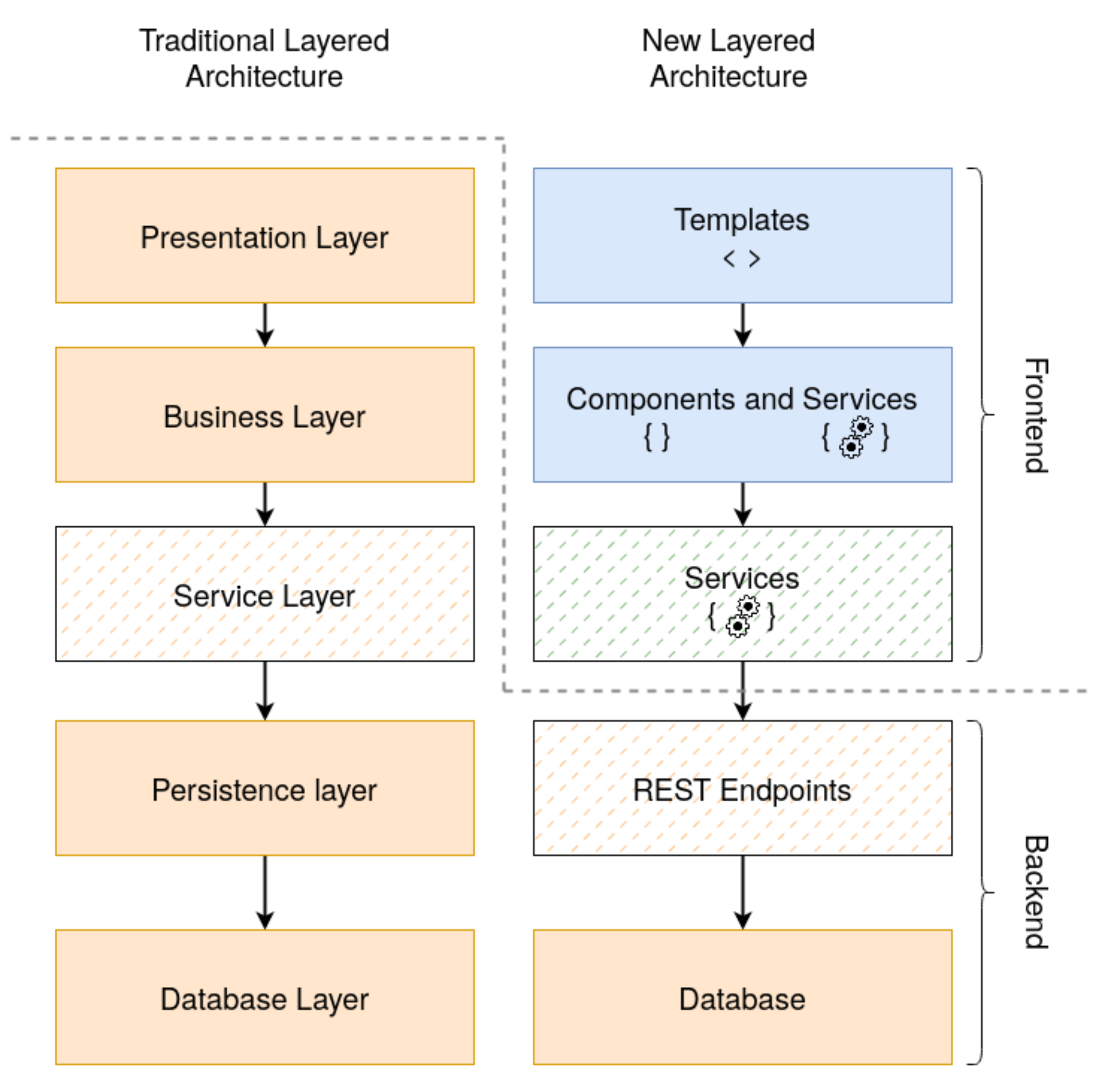

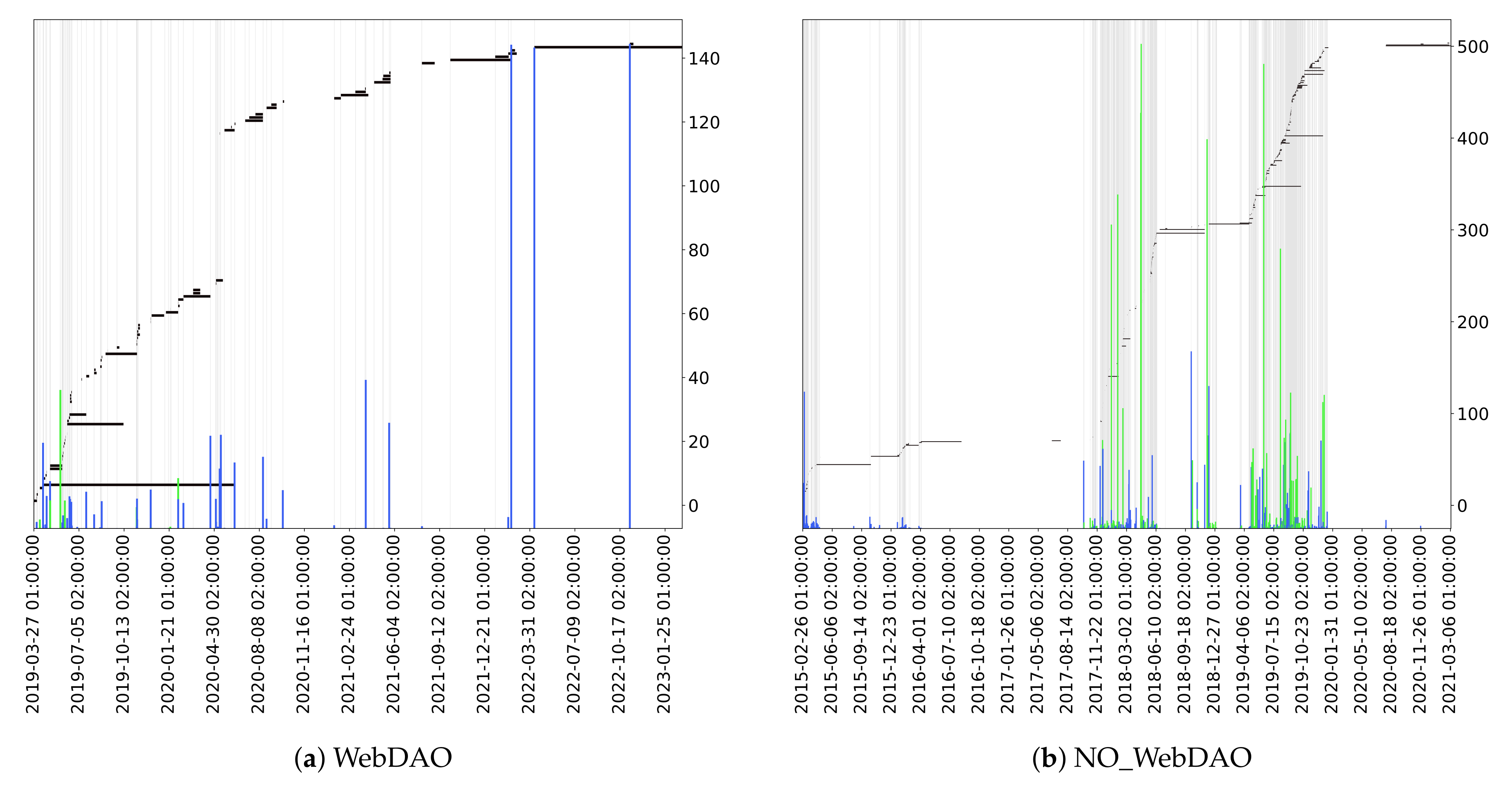
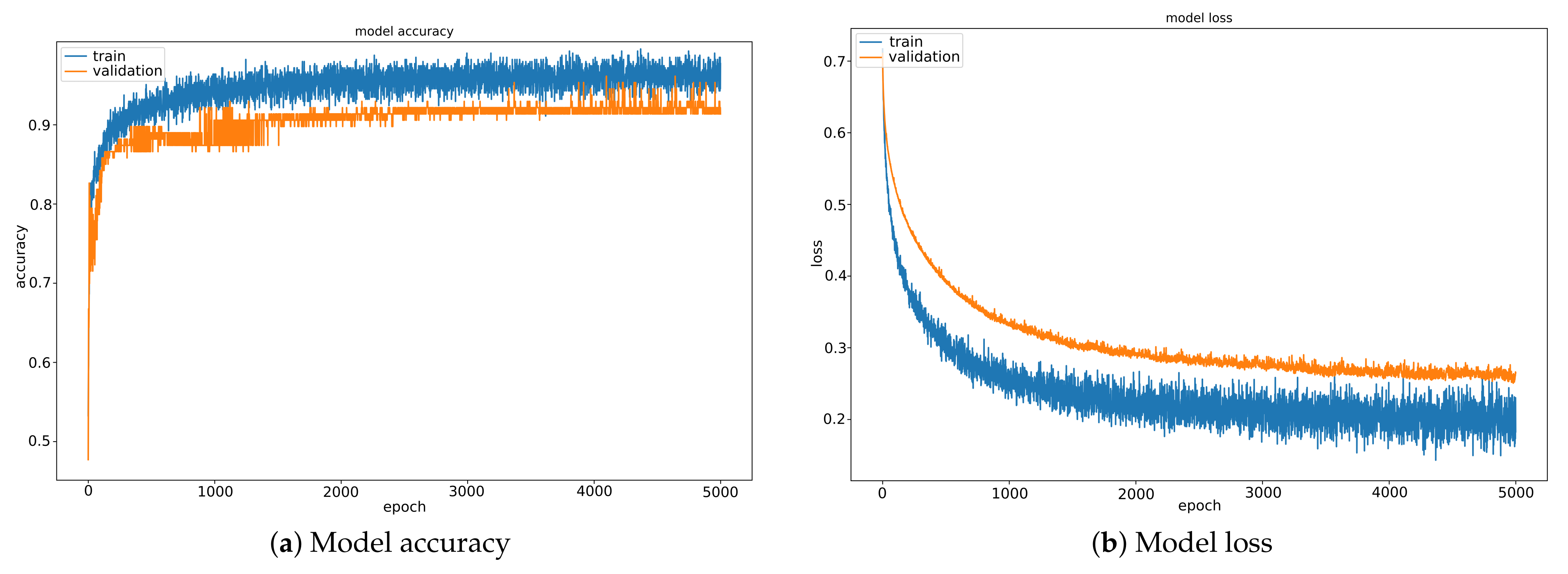



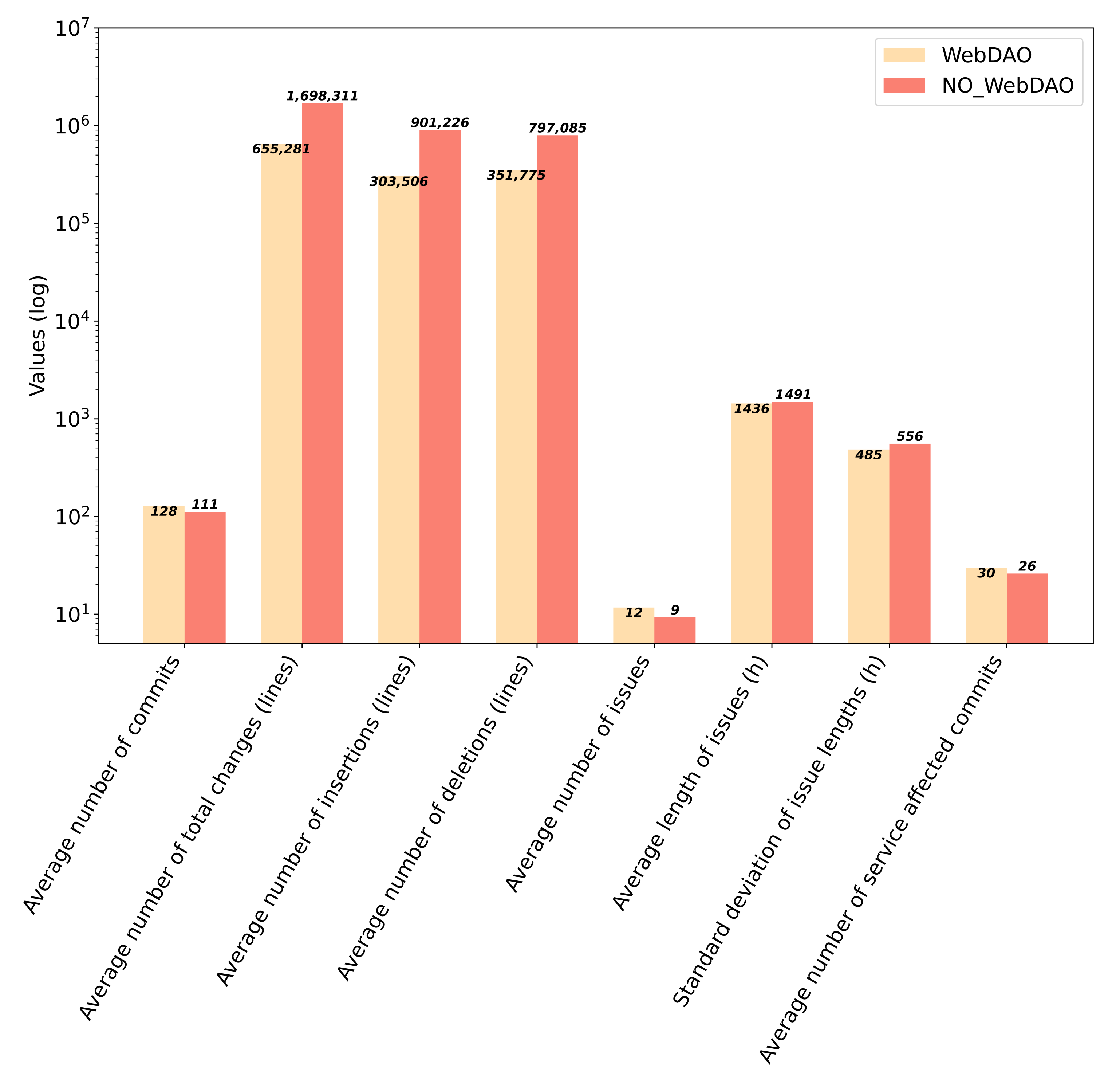
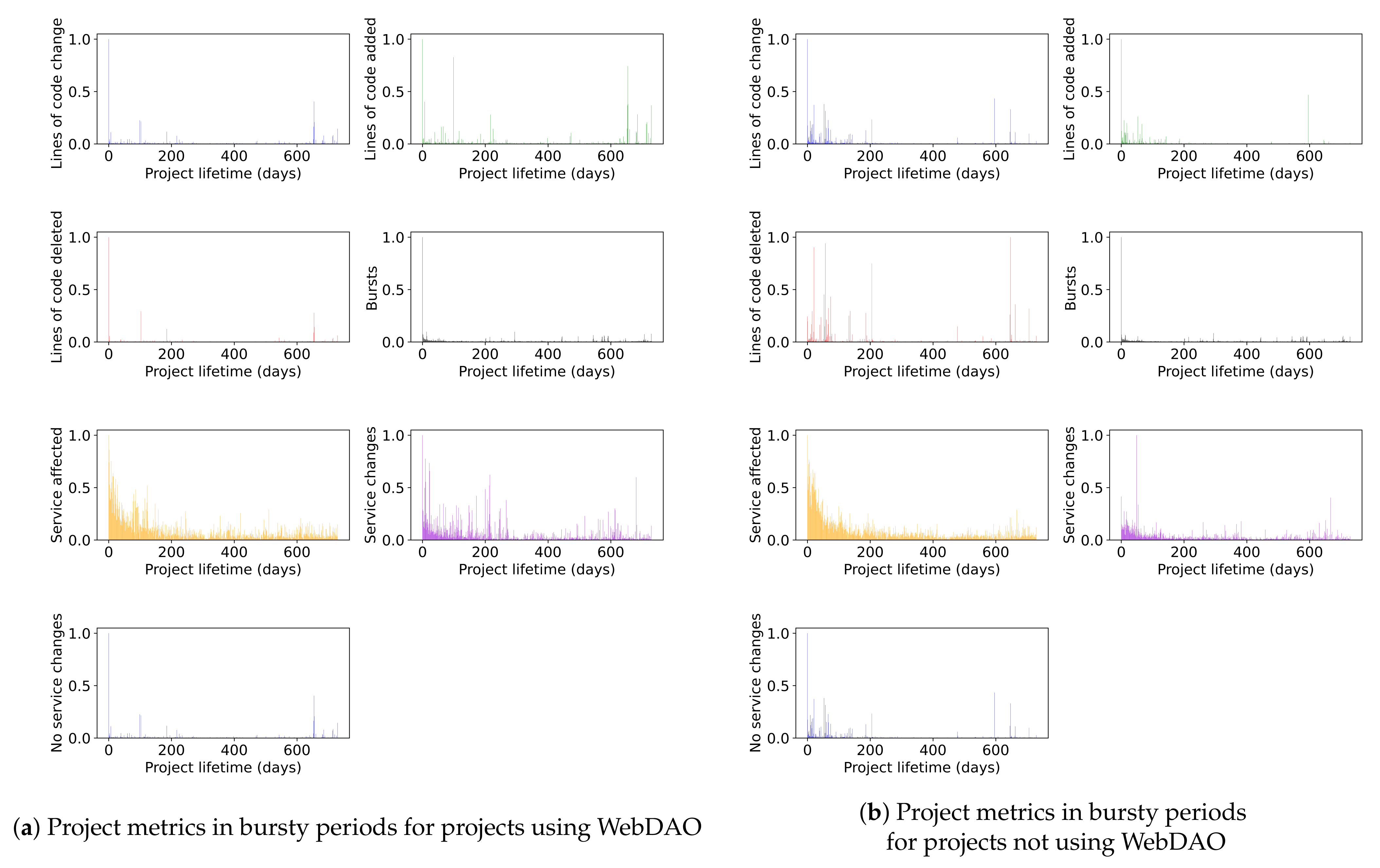
| Criteria | Implementation Technique |
|---|---|
| Abstraction | Must have an interface or class that describes the entity’s properties and is utilized for data manipulation. |
| Data persistence operations | At least the four CRUD operations are implemented for a given entity. |
| Data source independence | If the data source is modified, the returned values can be processed by the business logic without any source code modifications. |
| Distinct layer | WebDAO is implemented in a distinct file, similar to how a service is, and is therefore isolated. |
| Encapsulation | Data access logic is implemented in an importable or injectable component. |
| Transactions and error management | Exception handling must be error-specific. In serverless development, SDKs are responsible for this. |
| Testability | Testability can be controlled if WebDAO is partitioned at the file level. |
| Class | Precision | Recall | F1-Score |
|---|---|---|---|
| NO_DAO | 91% | 94% | 92% |
| DAO | 93% | 90% | 92% |
Disclaimer/Publisher’s Note: The statements, opinions and data contained in all publications are solely those of the individual author(s) and contributor(s) and not of MDPI and/or the editor(s). MDPI and/or the editor(s) disclaim responsibility for any injury to people or property resulting from any ideas, methods, instructions or products referred to in the content. |
© 2023 by the authors. Licensee MDPI, Basel, Switzerland. This article is an open access article distributed under the terms and conditions of the Creative Commons Attribution (CC BY) license (https://creativecommons.org/licenses/by/4.0/).
Share and Cite
Jánki, Z.R.; Bilicki, V. The Impact of the Web Data Access Object (WebDAO) Design Pattern on Productivity. Computers 2023, 12, 149. https://doi.org/10.3390/computers12080149
Jánki ZR, Bilicki V. The Impact of the Web Data Access Object (WebDAO) Design Pattern on Productivity. Computers. 2023; 12(8):149. https://doi.org/10.3390/computers12080149
Chicago/Turabian StyleJánki, Zoltán Richárd, and Vilmos Bilicki. 2023. "The Impact of the Web Data Access Object (WebDAO) Design Pattern on Productivity" Computers 12, no. 8: 149. https://doi.org/10.3390/computers12080149
APA StyleJánki, Z. R., & Bilicki, V. (2023). The Impact of the Web Data Access Object (WebDAO) Design Pattern on Productivity. Computers, 12(8), 149. https://doi.org/10.3390/computers12080149






